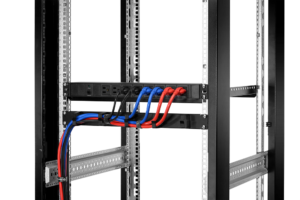Power Distribution Unit (PDU) is a reliable and cost-effective device to deliver power from a UPS system, generator, or utility source to multiple equipment by a single input with multiple output outlets. Rack mount power strip is the most basic PDU. They both supply power to the cabinet. But they have some differences. What’s the differences of upgraded PDU vs power strip? Continue to read this article.
What Is PDU
A PDU is a device fitted with multiple outlets. A PDU delivers AC power from power source to severs. PDU can be installed into a big cabinet with a power cord to transmit electric power to the computers and networking equipment located within a data center. Power cord can power a network device or connect to the PDU and computer in a data rack or network wiring closet. And C13 power cord is the best choice for PDU. In general, PDU is developing all the time. In the beginning, PDU is a simply and cheap rack mount power strip and then become larger floor mount PDUs with multiple functions.
Basic Introduction of Power Strip
Rack mount power strip is an electronic device that makes it possible for people to charge multiple electronic device at the same time. Power strip which we can also call it power bar or power board is a device with a block of charging stations. Power strip is often connected with the end of a flexible cable(a mains pug) and then you can plug it into the wall or other place. It has a long power cord that can be used anywhere. It is extremely convenient.
The Difference Between PDU and Power Strip
Application area
PDU can be installed in equipment racks which keep power within reach of rack mounted devices like severs, switches, routers, or cooling fans. The installation of PDU is more flexible and convenient which can be suitable for customer who is very strict about it. And PDUs are often used in data center, network closets and industrial environments. In addition, PDU can be for in-depth power management and monitoring. Power strip are widely used both at home and office for audio, video, computer system, appliances, lights, business and other appliances.
Electricity Consumption
Compared with power strip, PDU is designed more reasonable. It has more strict quality and standard. PDU can work over a long time without any problem. If you use PDU for a long time, you never worry about heat.
Safety
PDU has fundamentally eliminated the potential safety problems such as frequent power failure, burnout and fire caused by poor contact and low load. While a power strip fails to contribute functions what PDU can.
Conclusion
From this article, we know the basic knowledge about the PDU and rack mount power strip. Each kind of PDU can help data centers to improve monitoring and reduce operation costs. To choose basic PDU or other types of PDU, it totally depends on your own needs. If you want to purchase PDU, you can visit FS.COM.
